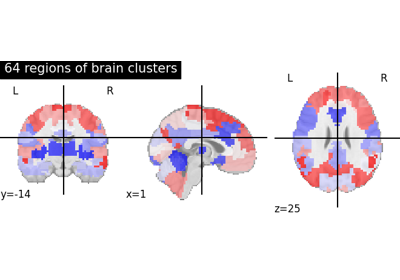Note
This page is a reference documentation. It only explains the function signature, and not how to use it. Please refer to the user guide for the big picture.
nilearn.datasets.fetch_atlas_basc_multiscale_2015#
- nilearn.datasets.fetch_atlas_basc_multiscale_2015(version='sym', data_dir=None, url=None, resume=True, verbose=1)[source]#
Downloads and loads multiscale functional brain parcellations.
This Deterministic atlas includes group brain parcellations generated from resting-state functional magnetic resonance images from about 200 young healthy subjects.
Multiple scales (number of networks) are available, among 7, 12, 20, 36, 64, 122, 197, 325, 444. The brain parcellations have been generated using a method called bootstrap analysis of stable clusters called as BASC 1, and the scales have been selected using a data-driven method called MSTEPS 2.
Note that two versions of the template are available, ‘sym’ or ‘asym’. The ‘asym’ type contains brain images that have been registered in the asymmetric version of the MNI brain template (reflecting that the brain is asymmetric), while the ‘sym’ type contains images registered in the symmetric version of the MNI template. The symmetric template has been forced to be symmetric anatomically, and is therefore ideally suited to study homotopic functional connections in fMRI: finding homotopic regions simply consists of flipping the x-axis of the template.
New in version 0.2.3.
- Parameters
- version{‘sym’, ‘asym’}, optional
Available versions are ‘sym’ or ‘asym’. By default all scales of brain parcellations of version ‘sym’ will be returned. Default=’sym’.
- data_dir
pathlib.Pathorstr, optional Path where data should be downloaded. By default, files are downloaded in home directory.
- url
str, optional URL of file to download. Override download URL. Used for test only (or if you setup a mirror of the data). Default=None.
- resume
bool, optional Whether to resume download of a partly-downloaded file. Default=True.
- verbose
int, optional Verbosity level (0 means no message). Default=1.
- Returns
- data
sklearn.utils.Bunch Dictionary-like object, Keys are:
“scale007”, “scale012”, “scale020”, “scale036”, “scale064”, “scale122”, “scale197”, “scale325”, “scale444”:
str, path to Nifti file of various scales of brain parcellations. Images have shape(53, 64, 52)and contain consecutive integer values from 0 to the selected number of networks (scale).“description”:
str, details about the data release.
- data
Notes
For more information on this dataset’s structure, see https://figshare.com/articles/basc/1285615
References
- 1
Pierre Bellec, Pedro Rosa-Neto, Oliver C. Lyttelton, Habib Benali, and Alan C. Evans. Multi-level bootstrap analysis of stable clusters in resting-state fmri. NeuroImage, 51(3):1126–1139, 2010. URL: https://www.sciencedirect.com/science/article/pii/S1053811910002697, doi:https://doi.org/10.1016/j.neuroimage.2010.02.082.
- 2
Pierre Bellec. Mining the hierarchy of resting-state brain networks: selection of representative clusters in a multiscale structure. In 2013 International Workshop on Pattern Recognition in Neuroimaging, volume, 54–57. 06 2013. doi:10.1109/PRNI.2013.23.
Examples using nilearn.datasets.fetch_atlas_basc_multiscale_2015#

Visualizing multiscale functional brain parcellations